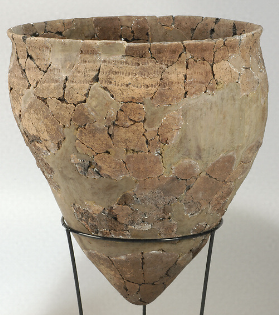
鈴谷文化
Susuya culture, すすや文化

鈴
谷式土器(北見市)
☆ 鈴谷(すすや)文化は、一部の学者によってオホーツク文化の最初期とも呼ばれ、サハリンや北海道北部を含むオホーツク海沿岸南部で発達した考古学的な沿岸漁撈・狩猟採集文化である。
︎▶鈴谷文化(このページ)︎▶続縄文(epi-Jomon)︎文化︎▶オホーツク文化(Okhotsk culture)︎▶擦文文化(Satsumon)︎︎▶︎トビニタイ文化(Tobinitai culture)▶︎︎
| The
Susuya culture, alternatively referred to as the earliest phase of the
Okhotsk culture by some scholars,[1] is an archaeological coastal
fishing and hunter-gatherer culture that developed around the southern
coastal regions of the Sea of Okhotsk, including Sakhalin and northern
Hokkaido. Classification Maeda (1987) considered the Susuya type pottery to be the marker of the earliest phase of the Okhotsk culture. However, some archaeologists argue that the Towada phase was the beginning of the Okhotsk culture and that the Susuya phase preceded the Okhotsk culture (Ohyi, 1982). It is certain that the Towada phase was included in the Okhotsk culture based on the results of not only archaeological investigations but also osteological studies. The present lack of human skeletal remains of the Susuya phase prevents definite statement whether the Susuya phase belonged to the Okhotsk culture.[1] Pottery Susuya ceramics are represented by round, sharp, and flat-based vessels with a wide open mouth. Decoration consists of compositions of string and comb impressions. Sites containing pottery of this kind are grouped within a separate Susuya culture. These are associated with Epi-Jomon traditions dating from the 5th to the 4th centuries in southern Sakhalin and from the 2nd to the 5th centuries in southern Sakhalin and northern Hokkaido.[2] Subsistence The subsistence pattern of the Susuya culture was much the same as that of the Okhotsk, consisting of sea-mammal hunting, sea gathering and some land gathering.[3] The Susuya focussed on the processing of intermediate trophic-level aquatic resources, and the early Okhotsk specialised towards isotopically enriched marine products. In the Susuya Culture household at Kafukai 2 (~100–500 CE), biomolecular evidence indicates that ceramic cooking pots were primarily used to process intermediate trophic-level anadromous resources, mixed sporadically with foods from the marine, terrestrial animal and plant food webs.[4] By paying close attention to the species of domestic animals, more dog remains than pigs have been found in the Susuya Shell Mound and Rutaka Site.[5] |
鈴谷(すすや)文化は、一部の学者によってオホーツク文化の最初期とも呼ばれ[1]、サハリンや北海道北部を含むオホーツク海沿岸南部で発達した考古学的な沿岸漁撈・狩猟採集文化である。 分類 前田(1987)は、須須弥型土器をオホーツク文化の最初期の指標と考えた。しかし、一部の考古学者は、十和田式土器がオホーツク文化の始まりであり、須 須弥式土器がオホーツク文化に先行すると主張している(Ohyi, 1982)。考古学的調査だけでなく、骨格学的調査の結果からも、十和田時代がオホーツク文化に含まれていたことは確かである。現在、十和田・栖鳳時代の 人骨が出土していないため、十和田・栖鳳時代がオホーツク文化に属するかどうかは断定できない[1]。 土器 須須屋式土器は、口が大きく開いた、丸く尖った扁平な土器に代表される。装飾は、紐や櫛の印象で構成されている。この種の土器を含む遺跡は、別の須須屋文 化に分類される。これらは、サハリン南部では5世紀から4世紀、サハリン南部と北海道北部では2世紀から5世紀にかけての縄文時代エピの伝統と関連してい る[2]。 生業 ススヤ文化の生計パターンはオホーツクのそれとほぼ同じで、海棲哺乳類の狩猟、海での採集、若干の陸上採集から成っていた[3]。ススヤは中間栄養レベル の水産資源の加工に重点を置き、初期のオホーツクは同位体濃縮された水産物に特化していた。カフカイ2のススヤ文化の家屋(~100~500CE)では、 セラミック製の調理鍋が主に中間栄養レベルの溯河性資源を加工するために使用され、海洋、陸上動物、植物の食物網からの食品と散発的に混合されていたこと を示す生体分子証拠がある[4]。家畜の種類に細心の注意を払うことで、ススヤ貝塚とルタカ遺跡からは豚よりも犬の遺骨が多く発見されている[5]。 |
リ ンク
文 献
そ の他の情報
Copyleft, CC, Mitzub'ixi Quq Chi'j, 1996-2099
☆
 ☆
☆